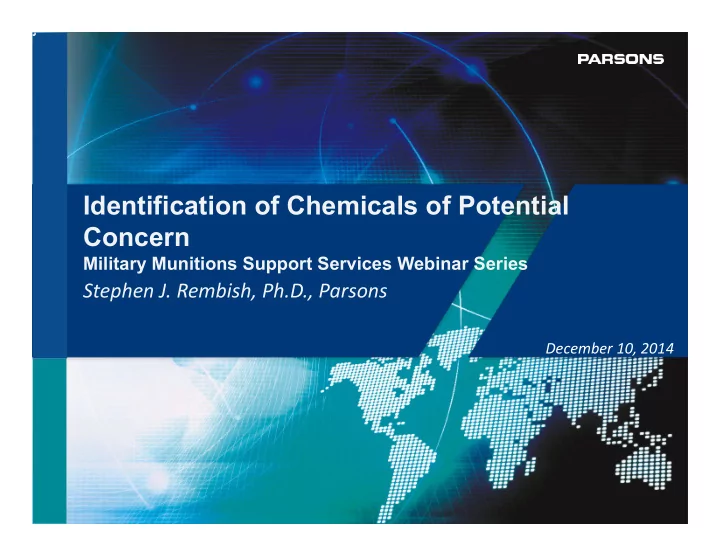

Identification of Chemicals of Potential Concern Military Munitions Support Services Webinar Series Stephen J. Rembish, Ph.D., Parsons December 10, 2014 ¡ ¡ ¡
Introduction � How chemicals of potenKal concern (COPC) selecKon fits in Military MuniKons Response Program projects � DefiniKon ¡of COPCs ¡ � Discussion will include: • IniKal development ¡of analyte lists • IdenKficaKon of COPCs • Current ¡issues • Final thoughts • Five minute Q/A 2
Development of Analyte List � “Preliminary COPCs” are selected based on known or suspected muniKons and explosives of concern (MEC) or muniKons debris (MD) • Analyte list ¡should be tailored to site, especially with regards to metals • Analytes may include explosives, metals, PAHs • EssenKal nutrients are generally not ¡included in analyte lists • Calcium, iron, magnesium, potassium, and sodium • Iron analysis may be jusKfied in some situaKons • Carefully evaluate need for arsenic analysis • Arsenic is not ¡a common component ¡of ordnance items • Common soil component ¡present ¡at ¡concentraKons exceeding screening values 3
Development of Analyte List, continued � Special consideraKons • Analyte lists at ¡small arms ranges should be focused on small arms muniKons indicator metals (anKmony, copper, lead, and zinc) at ¡target/impact ¡areas • Analyses at ¡firing lines may include explosives • Analyses at ¡skeet ¡ranges may also include polycyclic aromaKc hydrocarbons (PAHs) ¡ – Not ¡an MC – Components of clay pigeons • Burn pits • Evaluate need for PAH ¡and BTEX ¡ 4
Identification of COPCs � Metals detected greater than selected background • More in a few minutes! � Other preliminary COPCs (e.g., explosives) detected greater than preliminary screening values (PSVs) ¡ � PSVs consist ¡of the more conservaKve value of the selected human health screening value and the selected ESV • U.S. Environmental ProtecKon Agency (USEPA) Regional Screening Levels ¡(RSLs) ¡commonly used ¡ • Updated biannually • State may have own human health screening values and/or ESVs • Most ¡current ¡screening values applied at ¡dra< report ¡phase 5
Comparison to Background � Metals are naturally occurring, so biased concentraKons should be compared selected site-‑specific background concentraKons • Other preliminary COPCs may be present ¡due to non-‑military anthropogenic sources and may be compared to background to determine if a release due to military use has occurred • For example, PAHs may also be aMributable to forest ¡fires, asphalt, industrial emissions � Current ¡issues • Can analytes present ¡at ¡concentraKons less than background be removed from further consideraKon? 6
Current Issues • US Department ¡of Defense Manual: Defense Environmental RestoraKon Program (DERP) Management (Number 4715.20, March 9, 2012) specifically states (p 32) that ¡(USEPA RAGS Part ¡A, based) human health “ Risk assessments should not ¡ quan>fy exposure to naturally occurring substances present ¡ at ¡concentra>ons unaffected by current ¡or past ¡site ac>vi>es. ” � State Guidance Varies 7
Current Issues � Tri-‑Service PosiKon Paper on Background Levels in Risk Assessment; USACE CX, Omaha, NE (October 2011), describes the consideraKon of background levels in idenKfying and evaluaKng site-‑related chemicals and non-‑site-‑related chemicals. “ A clear understanding of the chemicals released from ¡a site and site background condi>ons is an important ¡aspect ¡of this approach: • Site chemical concentra>ons should be compared to risk-‑based screening levels. • Site chemical concentra>ons should be compared to background levels. • Chemicals that ¡are above risk-‑based screening levels and background levels should be iden>fied as site-‑related COPCs. • Chemicals that ¡are above risk-‑based screening levels, but ¡below background levels should be iden>fied as non-‑site-‑related COPCs. 8
Current Issues � EPA Guidance • USEPA’s Guidance for Comparing Background and Chemical ConcentraKons in Soil for CERCLA Sites (EPA, 2002) • “In light ¡of more recent ¡guidance for risk-‑based screening (EPA, 1996; EPA, 2000) and risk characterizaKon (EPA, 1995c), this policy recommends a baseline risk assessment ¡ approach that ¡retains consKtuents that ¡exceed risk-‑based screening concentraKons. This approach involves addressing site-‑specific background issues at ¡the end of the risk assessment, in the risk characterizaKon.” • When concentraKons of naturally occurring elements at ¡a site exceed risk-‑based screening levels, that ¡informaKon should be discussed qualitaKvely in the risk characterizaKon. 9
Final Thoughts � Importance of early team discussion and concurrence on potenKally contenKous issues • IdenKficaKon of Analyte Lists and appropriate MDLs • IdenKficaKon and Use of PSVs • Background comparison • Where in the process • Method of comparison 10
Questions? 11
Recommend
More recommend